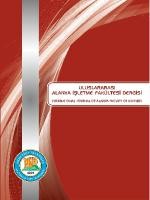Sağlık Kurumlarında Parasal Olmayan Maliyetler, Algılanan Değer ve Hasta Memnuniyeti
Parasal Olmayan Maliyetler, Algılanan Hizmet Kalitesi, Hasta Tatmini, Sağlık Kurumları
Sağlık Kurumlarında Parasal Olmayan Maliyetler, Algılanan Değer ve Hasta Memnuniyeti
-,
___
- ALI, H.M. (2007). “Predicting The Overall Perceived Value Of A Leisure Service”, Master Thesis, University of Pretoria
- BLOEMER, J. and ODEKERKEN-SCHRODER, G. (2002). “Store satisfaction and store loyalty explained by customer-and storerelated factors”, Journal of Customer Satisfaction, Dissatisfaction and Complaining Behavior, Vol. 15, pp. 68-80.
- BOLTON, R.N. and DREW, J.H. (1991). “A Multistage Model of Customers’ Assessments of Service Quality and Value”,”Journal of Consumer Research, 17(March), 375–384.
- BROWN, S.W., NELSON, A.M., BRONKESH, S.J., and WOOD, S.D. (1993). Quality Service For Practice Success, Aspen Publication, Maryland.
- DODDS, W.B., MONROE, K.B., and GREWAL, D. (1991), “Effects of Price, Brand and Store Information on Buyers’ Product Evaluations”, Journal of Marketing Research, Vol. 28, No. 3, pp. 307-319
- DODDS, W.B. and MONROE, K.B. (1985). “The effect of brand and price information on subjective product evaluation”, Advances in Consumer Research, 12, 85-90.
- GIMPEL, G. (2011). Value-driven Adoption and Consumption of Technology:Understanding Technology, Decision Making, Copenhagen Business School Press, Danmark
- HUNT, K.H. (1977). CS/D:Overview and Future Research Directions in Conceptualization and Measurement of Consumer Satisfaction and Dissatisfaction, Marketing Science Institute, Massachusetts
- IGLESIAS, M.P. and GUILLEN, M.J. (2004). “Perceived Quality and Price: Their Impact On The Satisfaction Of Restaurant Customers”, International Journal of Contemporary Hospitality Management, Volume 16, Number 6, pp. 373-379
- KAVUNCUBAŞI, Ş., and YILDIRIM, S. (2010). Hastane ve Sağlık Kurumları Yönetimi, 2. Baskı, Siyasal Kitabevi, Ankara
- KEEGAN, O., MCDARBY, V., TANSEY, A. and MCGEE, H. (2003). Community involvement in A/E satisfaction survey
- KOTLER, P., and KELLER, K. (2006). Marketing Management (12th ed.).Upper Saddle River, NJ: Pearson
- MOLINER, M.A. (2009). “Loyalty, Perceived Value and Relationship Quality In Healthcare Services”, Journal of Service Management, Vol. 20 No. 1, pp. 76-97, Emerald Group Publishing Limited, 1757-5818
- MONROE, K.B. (1990). Pricing: Making Profitable Decisions. (2nd ed.), McGraw-Hill Book Company, New York
- MONROE K.B. (2002). Pricing: Making Profitable Decisions (3rd ed.), McGraw-Hill Book Company, New York
- NELSON, E.C., HAYS, R.D., LARSON, C. and BATALDEN, P.B. (1989). “The Patient Judgment System: Reliability And Validity”, Quality Review Bulletin, 15, 185–191
- PETRICK, J.F. (2002). “Development of a Multi-Dimensional Scale for Measuring the Perceived Value of Service”, Journal of Leisure Research, vol.34, no. 2, pp. 119-134.
- PORTER, M.E. (1990). The Competitive Advantage of Nations, Macmillan Press, New York
- OLIVER, R.L. (1981). “Measurement and Evaluation of Satisfaction Processes in Retail Settings”, Journal of Retailing, 57(Fall), 25–48 PANDŽA, I., V RANEŠEVIĆ, T. (2008). "Measurement of perceived value in banking services", The 4th International Conference of the School of Economics and Business, University of Sarajevo (ICES), Sarajevo, Bosnia and Herzegovina
- PORTER, M.E. (1990). The Competitive Advantage of Nations, Macmillan Press, New York
- SANCHEZ, J., CALLARISA, L., RODRIGUEZ R.M., and. MOLINER, M.A. (2006). “Perceived Value of the Purchase of a Tourism Product”, Tourism Management, Vol.27, pp.394-409
- ZEITHAML, V. (1988). “Consumer Perceptions of Price, Quality and Value: A Means-End Model and Synthesis of Evidence”, Journal of Marketing, 52(2), 2-22.
- ISSN: 1309-1522
- Başlangıç: 2015
- Yayıncı: Akdeniz Üniversitesi
Sürdürülebilir Büyüme Kavramının Çevre ve Ekonomik Boyutlarının Ayrıştırılması
Sağlık Kurumlarında Parasal Olmayan Maliyetler, Algılanan Değer ve Hasta Memnuniyeti
Kurumsal İtibarın İşgören Performansı Üzerindeki Etkisinin Belirlenmesine Yönelik Bir Araştırma
Tuba BEKİŞ, Ali BAYRAM, Mustafa ŞEKER
Havayolu Yolcu Taşıma İşletmelerinin Finansal Etkinliklerinin Ölçümüne İlişkin Bir Araştırma
Mehmet Akif ÖNCÜ, İstemi ÇÖMLEKÇİ, Erhan COŞKUN
Global Ekonomik Krize Karşı Çok Uluslu Şirketler İçin Uygun Finansal Stratejiler
Gürcistan Ulus İnşa Çabalarının Önünde Bir Engel: Cavahati Ermenileri
Timuçin KODAMAN, Adem Ali İREN
Endeks Futures ve Spot Piyasalarda Fiyat Keşfi:1982'den Günümüze Bir Literatür Araştırması
